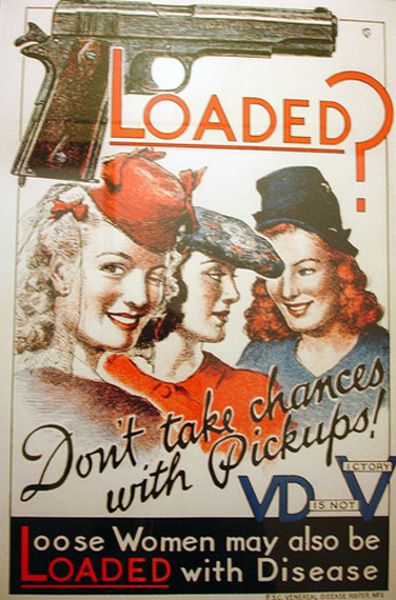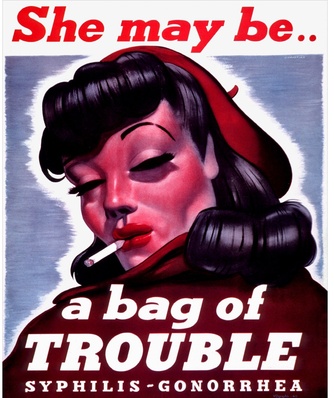Why Study Female Sexuality?
Why study female sexuality in a moment when so many people feel that they are “non-binary”? The short answer is because of the long history of diminishing, dismissing, misrepresenting, and even weaponizing women’s sexuality.
In 1918, Nina McCall, then a teenage girl, was confronted on the sidewalk by her town’s sheriff and ordered to immediately submit to a medical examination. Nina had never undergone a gynecological exam before, (and as such, this experience left her traumatized and bleeding), nor had she had any sexual contact with a man. So when the medical officer told her she had gonorrhea, she understandably protested. The doctor “turned on her and thundered, with all the authority of his position and his gender, ‘Young lady, do you mean to call me a liar?’” Nina was ultimately remanded to a detention hospital.
During World War II, the government commissioned artists to make propaganda posters comparing “loose” women to loaded guns:

These are two examples of the “American Plan,” a “social hygiene” campaign ostensibly devised to protect the nation from sexually transmitted infections. As a result of the Plan, tens or perhaps hundreds of thousands of allegedly "promiscuous" American women were quarantined, detained, and forced to undergo gynecological exams—that is, sexually assaulted. (If you’re interested in learning more about the American Plan, check out THE TRIALS OF NINA McCALL Sex, Surveillance, and the Decades- Long Government Plan to Imprison “Promiscuous” Women by Scott W. Stern, or his article in Time.) Epidemiologists participated in creating this “public education campaign.” It’s commonly known that women are more susceptible to infection than men—Dr. Debby Herbenick says, “In terms of anatomy, vaginas leave women more exposed and vulnerable to sexually transmitted infections than male anatomy, since the penis is covered with skin which serves as a good barrier for several STIs.” So why would epidemiologists figure “loose” women as vectors of transmission and infection? They were creating a pretext to show men and women alike that female sexuality, untethered from male control, is dangerous and morally corrosive. It is literally a "national disease."
But that was in the early 20th Century, surely we’re more enlightened than that now, right? Wrong. A psychiatrist recently told me about a harrowing experience a female patient of hers had in an emergency room—in 2019. The patient sometimes experienced acute and debilitating anxiety; during one such episode, she called her psychiatrist who suggested they meet at the local hospital emergency room. The patient showed up early. By the time the psychiatrist arrived, her patient had been diagnosed as manic depressive by the ER’s attending physician, an "experienced" male doctor, and she’d been given antipsychotics. When the psychiatrist protested that her patient did not have bipolar disorder and did not need medication, the attending physician said he’d taken the patient’s sexual history and upon hearing she’d had six partners in 13 months, presumed that a woman with such a “high” partner count must be in the throes on a manic episode. It couldn’t be that the woman simply enjoyed sex—no, it must be mental illness. But this kind of oppression happens at the state level, as well. Make no mistake: bills like the ones just passed in Ohio, Georgia, and Alabama to ban abortion at conception are attempts by the state to control women’s sexuality by controlling their reproductive choices.
And it’s much worse for women of color. Going back to our country’s founding, the rape of enslaved women was justified by their “inherent” sexual insatiability, their “innate” promiscuity. Fast forward to the American Plan, which hugely disproportionately victimized black women, and we see that these deep-rooted stereotypes were maintained, as the implementers of the Plan “enthusiastically warned that nonwhite women were less moral, intent on infecting soldiers and that blacks in particular were a ‘syphilis soaked race.’”
In more recent history, scholars like bell hooks, Patricia Hill Collins, and Mireille Miller Young examine how sexuality has been used to keep black women in particular contained. Young, for instance, has written extensively on the fact that within sex work like stripping or pornography, where black bodies are highly fetishized and exoticized, black workers make substantially less money under substantially worse conditions. In Young’s words, “it speaks to the ways in which there's this simultaneous problem: a deep desire to have those bodies present and to consume those bodies as commodities, but a deep disgust for black people, our humanity and our bodies, at the same time that allows that devaluing to function.”
What is it about female sexuality and sexual expression that society finds so threatening? Why did we create a culture wherein women who lust think of themselves as freaks—and supposed medical professionals diagnose them as literally mentally ill?
I study and write about female sexuality because of the long history and present moment where women have their sexuality dictated to them by men in power. And it’s time for a change.
